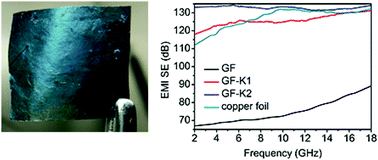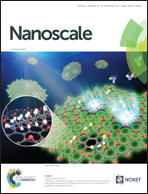Large-area potassium-doped highly conductive graphene films for electromagnetic interference shielding†
Abstract
As promising carbonaceous films, graphene films (GF) have exhibited many remarkable mechanical and electrical/thermal properties of great potential for wide functional applications. However, the electrical conductivity of GF still needs to be improved and the limitation lies in the low carrier density of pure graphene. Here, we presented a post-doping method for large-area potassium doped graphene films (GF-K) and promoted the electrical conductivity of GF approaching benchmark metals. The macroscopic-assembled GF-K shows a similar color to graphite intercalation compounds. The potassium doping increased the carrier density of the GF without undermining the electronic quality of the graphene unit. The doping concentration was optimized to prepare stage-2 GF-K (C24K) with the highest electrical conductivity (1.49 × 107 S m−1), holding merits of low density (1.63 g cm−3), and high flexibility. Doped GF with better specific electrical conductivity than copper showed outstanding electromagnetic interference shielding performance. Shielding effectiveness (SE) increased from 70–85 dB for graphene film (GF) to over 130 dB for GF-K only at 31 μm thickness, which is among the best SEs in previous reports. The combination of high specific conductivity, mechanical flexibility, high EMI SE, light weight, and facile productivity enables GF-K to be promising in many high-end EMI applications such as aerospace and wearable devices.



 Please wait while we load your content...
Please wait while we load your content...